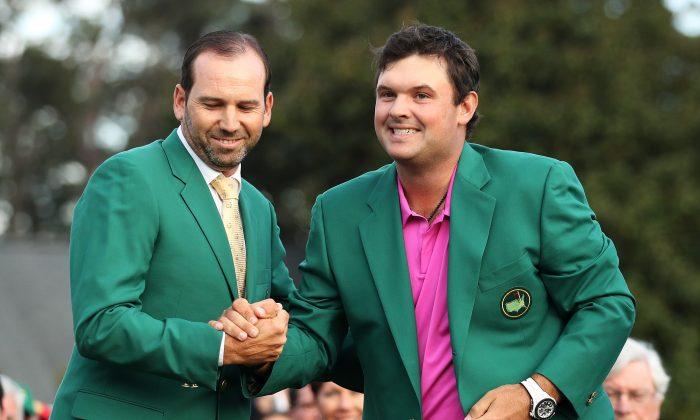SPRINGFIELD, NJ—The 98th PGA Championship returns to Baltusrol Golf Club for the second time in eleven years and the event celebrates the 100th anniversary of the founding of the PGA which commenced its first event at Siwanoy Country Club in nearby Westchester County (NY) in 1916.
Baltusrol is no stranger to national competitions. The PGA Championship marks the 17th major event played on the grounds—seven U.S. Opens and now two PGA Championships among the various key competitions that have been held here. Baltusrol is blessed with two renown courses—the Lower and Upper with the former once again holding center court as the host layout.
The famed architect A.W. Tillinghast designed both layouts and in the years that followed Robert Trent Jones, Sr. played a significant role in updating the course for the 1954 U.S. Open. Interestingly, his son Rees did a number of improvements to both courses in recent years so that the Lower and Upper respectively remain relevant to championship events in the 21st century.
The architectural roundtable discusses the impact Baltusrol has had in major championship golf and what steps the PGA of America may take with its flagship event in the years to come.

* * *
MATT WARD: This year’s PGA Championship returns to Baltusrol Lower for the second time in eleven years. The Springfield, NJ club is a A.W. Tillinghast design but has been updated by both Robert Trent Jones, Sr. and his son Rees in recent years. Numerous changes have been made over a 50+ year time frame—when do such efforts go from being a restoration to a totally new updating and how should the latter work be highlighted?
GRAHAM COOKE: In my opinion a great course like Baltusrol should always be respected as a A.W. Tillinghast design. Any one hired to make modifications should do so with the mind set that A.W. is walking by their side. It’s his design and can be modified for many reasons but the changes need to enhance the course character not change it.
DOUG CARRICK: The word restoration is often misused when referring to golf course design. A true restoration would return all features of the golf course to their original location and form. This rarely, if ever, is the approach taken. That being said, a golf course restoration project typically attempts to retain the design style and character developed by the original architect. If the original design style is changed, then the project is more likely to be referred to as a renovation or updating rather than a restoration.
MARTIN EBERT: Restoration, in my view, is paying great heed to the characteristics and features of the original course, or the course at some point during its evolution, and returning those characteristics and features to the course. I feel that projects on historic courses should combine restoration of old features and the creation of new ones—a combination of restoration and new updating.
STEPHEN KAY: A totally new updating would be if the green contours are changes as well as most of the sand bunker locations. It would be hard for the media or even the PGA to highlight changes since changed have always been going on at most clubs. Think about how the trees have changed over the years; from small trees that grow—hence possibility changing shot angles—to trees being removed. Most people just think about bunkers and green contours but there is a lot more than that.

MW: Kerry Haigh is the PGA of America’s official who handles the course set-up for each of the Association’s major golf events. If you were in Haigh’s role, what would you do regarding course set-up to effectively challenge the world’s best players at the PGA Championship?
SK: I like what Mike Davis of the USGA has done with the rough getting higher as you miss the fairway, but I do not like super fast greens—this just hurts the game. I like the green speeds used for The Open Championship. The greens were 9.5 on the Stimpmeter—just perfect.
ME: The course set up should encourage decision making. Golf should be a game played in the mind as well as physically. Getting players to take different strategies for playing a hole, especially from the tee, should be the goal rather than dictating just one.
DC: I would try to provide as much variety as possible in the length and type of approach shots required. I would also insist on dry, firm fairways and greens that produce a good degree of bounce and roll on the ball. These type of conditions require more creative shot making. The length of rough would be moderate as opposed to severe. This would provide for a greater variety of recovery shots, with exceptional shots being rewarded with good results and poorly executed shots being penalized.
GC: If I was in charge I would look for a balanced set-up that allows players to experience this great course over four days. This course can take care of itself with regard to challenge. No need to reach for extremes in grass heights or green speeds. Let the pros play golf, their good at it.

MW: Just a quick “yes” or “no”: should architects be consulted with what is ultimately done at facilities they have designed—specifically when big time tournaments are played?
ME: Yes. Definitely.
GC: Yes.
SK: Big yes.
DC: Absolutely yes.

MW: The PGA of America might decide in the near term to stage their premier event at a location outside of the United States for the first time. Possibly, that event would be timed to precede the Masters and a specific location in either the Southern Hemisphere or other warm location. If you could choose one specific course for the PGA Championship to be contested internationally which course would you recommend and why?
DC: Kingston Heath in Melbourne Australia because it is a superb test of golf on a beautiful natural site in the sand belt area of Melbourne. It also has some of the best bunkering in the world.
GC: I would like to see the PGA take the championship to Europe. Maybe to a great course like the Torino Golf Club in Italy. The reasoning is that the European pros have for decades supported the fourth major. Europe and England would appreciate a PGA championship played on their soil. This is needed to set a balance and to show support of this strong zone of professional golfers. Time to give the PGA major a rotational, international flavor—I see it being good for the game.
ME: I would take it to the Indian Subcontinent to encourage the game in a developing golfing region. In fact, I would take it to the Victoria Golf and Country Club in Sri Lanka. This is a most stunning inland course set in the mountainous hills near Kandy beside the shores of the Victoria Reservoir.
SK: I am not sure I like the idea, but if so I would pick the Caribbean maybe Pete Dye’s Tooth of the Dog in the Dominican Republic.

MW: Consecutive par-5’s end the round on Baltusrol Lower. No other active championship course ends in such a manner. What’s your take on that and why has it not been done in other instances?
SK: I like it. It has not been done at other majors I assume because the design of those courses did not have it and they probably didn’t even think of remodeling to create two par 5’s in a row.
DC: One of the greatest aspects of golf is that there are no set dimensions for the field of play. A golf course can be any size, shape or configuration that the course designer envisions. Back-to-back par-5s to finish the round should provide some very exciting opportunities for players in contention to make up ground on the leaders with back to back birdies or eagles.
ME: Two par-5s together is absolutely fine by me. There are no rules—and there should not be—in golf course design and two par-5s gives so much potential for change and excitement at the end of a 72-hole tournament so long as those par-5s have the capacity for high scores as well as low scores.
GC: No there are not too many courses that end this way as designers try to balance the pars throughout a course. However that said one of golf’s design strengths is it’s design flexibility. No set rules here, no need to measure the height of the net, golf design use a full canvas and the painting is up to the artist.

MW: Baltusrol is a 36-hole facility and there are a number of members at the club who see the sister course—the Upper—as being superior to the Lower. Do you have any specific courses you would highlight as being in the shadows of another course—whether at the same facility or in immediate area that often gets second billing?
GC: The sister course to the Blue course at Royal Montreal Golf Club is The Red Course. The Blue course is the celebrated course, having hosted many Canadian opens but the Red course is a sleeper. It deserves special recognition as one of Dick Wilson’s finest designs.
ME: The Valley Course at Royal Portrush is a wonderful shorter links compared to its more famous Dunluce. The Annesely Links at Royal County Down is even shorter than the Valley Course at Portrush and yet it has some fantastic holes and is a great model for shorter, more sporty golfing fun.
DC: The Old and New Courses at Sunningdale near London are both very highly regarded courses and in most cases get equal billing, although I believe the Old Course to be superior to the New Course. However, there are several other great Heathland Courses in the same general area that often get overlooked including Swinley Forest and Berkshire which are both outstanding Heathland Courses.
SK: Winged Foot first comes to mind. The East is maybe an overall better course than the West. Also the Red course at Bethpage could hold a PGA event—maybe not a major but a tour stop.

MW: In the early 1950’s Robert Trent Jones, Sr. was hired by Baltusrol to upgrade the layout prior to the hosting of the 1954 U.S. Open. The changes implemented were not universally praised—specifically the new par-3 4th over a fronting pond. Jones was brought to Baltusrol and with members in tow taken to the 4th. Jones proceeded to make a hole-in-one and pronounced the hole “eminently fair.” Have you ever had a specific instance where your efforts at improving a specific course were not understood or appreciated fully? What was the ultimate outcome?
DC: There are many cases when I have recommended changes at an older course that were not universally accepted or fully appreciated. It is often difficult to get consensus among 400 to 500 members who have varying opinions or have difficulty visualizing the changes proposed. A great deal of patience is often required to allow members time to think about the potential improvements and how they might influence play and the overall experience. In most cases when the improvements have been made the majority of members have been happy with the results.
ME: Generally the stage at which redesign proposals are questioned is before they are implemented but, assuming that I have ended up happy with the outcome, the members and golfing world have been happy too. One thing to add though: my experience with classic courses has led me to believe that erring on the side of conservatism is the most sensible policy. Wild original features on old courses are prized but adding wild features, such as a heavily contoured green, to old courses will be heavily criticized.
SK: I redid a par-5 green which was too small and in bad shape soil wise. After showing the green committee five different plans they wanted the most difficult design of the five—contour and angle of the green—but wanted me to make it even more challenging. I said this will be very difficult for the average players at their club they said they thought it would be fine. After it was built and they played it for a year they said it was too difficult and are considering re-doing the green again. I guess they should have listened.
GC: I was honored with the task of reviving The Highland links course of famed past architect Stanley Thompson. This was a wondrous, wild course set beside the ocean and scenic Clyburn Brook in Cape Breton, Canada. The course had slowly been taken over by forest and neglect. This was a hidden gem and needed only to be given a respectful restoration. The government expected me to modernize the course and bring it into the present. I refused and they finally relented. The course after the restoration vaulted to the world ranking list where its rest today. Stanley Thompson in my opinion would have approved of the painstaking care to breath life back into his finest work.

 Graham Cooke, is the principal of Graham Cooke & Associates, Inc. located in Hudson, Quebec, Canada and which opened in 1973. Earned a degree in landscape architecture from Michigan State University and has designed over 100 courses across the globe and has received numerous best new Canadian courses awarded by Golf Digest. Recently enhanced Torino Golf Course in Italy for the Italian Open and designed Country Club of Vermont and Loomis Trail in Washington State. Cooke is also a member of the Canadian Golf Hall of Fame.
Graham Cooke, is the principal of Graham Cooke & Associates, Inc. located in Hudson, Quebec, Canada and which opened in 1973. Earned a degree in landscape architecture from Michigan State University and has designed over 100 courses across the globe and has received numerous best new Canadian courses awarded by Golf Digest. Recently enhanced Torino Golf Course in Italy for the Italian Open and designed Country Club of Vermont and Loomis Trail in Washington State. Cooke is also a member of the Canadian Golf Hall of Fame.
 Douglas Carrick is President of Carrick Design Inc. Began his career in golf course design in 1981 under the tutelage of the late C.E. “Robbie” Robinson, who schooled Carrick in the classic design principles that were passed onto him by the renowned golf course architect, Stanley Thompson. Carrick Design was founded in 1985 and has designed & renovated more than 60 golf courses worldwide, including The Carrick on Loch Lomond in Scotland. The firm has won numerous design awards from Golf Digest, Golf Magazine, ScoreGolf magazine and several others. Five of Carrick`s Courses have hosted PGA Tour, LPGA Tour and European Tour events. He is a member of the American Society of golf Course Architects since 1988 and served as President in 2010.
Douglas Carrick is President of Carrick Design Inc. Began his career in golf course design in 1981 under the tutelage of the late C.E. “Robbie” Robinson, who schooled Carrick in the classic design principles that were passed onto him by the renowned golf course architect, Stanley Thompson. Carrick Design was founded in 1985 and has designed & renovated more than 60 golf courses worldwide, including The Carrick on Loch Lomond in Scotland. The firm has won numerous design awards from Golf Digest, Golf Magazine, ScoreGolf magazine and several others. Five of Carrick`s Courses have hosted PGA Tour, LPGA Tour and European Tour events. He is a member of the American Society of golf Course Architects since 1988 and served as President in 2010.
 Martin Ebert, 49 years old, works as a golf course architect for Mackenzie & Ebert located in Chichester, England. A golfing career became his goal following the organization of the Cambridge University’s US tour in 1989 where we played Pine Valley Merion, Shinnecock Hills, National Golf Club of America, The Country Club and Baltusrol amongst others. His golf course design began in 1990 with Donald Steel & Company leading to working experiences in over 20 countries. Mackenzie & Ebert was formed in 2005 with seven of the nine Open venues being advised by the company along with many new course projects around the world. This includes the changes to the recently reopened Ailsa Course at Turnberry and the changes, including two new holes, at Royal Portrush for The Open Championship of 2019. Ebert also acts as a referee at events including The Open Championship.
Martin Ebert, 49 years old, works as a golf course architect for Mackenzie & Ebert located in Chichester, England. A golfing career became his goal following the organization of the Cambridge University’s US tour in 1989 where we played Pine Valley Merion, Shinnecock Hills, National Golf Club of America, The Country Club and Baltusrol amongst others. His golf course design began in 1990 with Donald Steel & Company leading to working experiences in over 20 countries. Mackenzie & Ebert was formed in 2005 with seven of the nine Open venues being advised by the company along with many new course projects around the world. This includes the changes to the recently reopened Ailsa Course at Turnberry and the changes, including two new holes, at Royal Portrush for The Open Championship of 2019. Ebert also acts as a referee at events including The Open Championship.
 Stephen Kay, ASGCA has been practice since 1983 and has done renovation work at more than 250 golf courses plus 20 new golf courses. Stephen also teaches design history and principles at Rutgers University. Examples of work, Links of North Dakota, Architects GC, and recent restorations Llanerch, Forsgate and the Union League GC at Torresdale a Donald Ross design.
Stephen Kay, ASGCA has been practice since 1983 and has done renovation work at more than 250 golf courses plus 20 new golf courses. Stephen also teaches design history and principles at Rutgers University. Examples of work, Links of North Dakota, Architects GC, and recent restorations Llanerch, Forsgate and the Union League GC at Torresdale a Donald Ross design.
M. James Ward, a member of Golf Writer’s Association of America (GWAA) and past member of Met Golf Writer’s Association (MGWA), has reported on golf’s grandest events since 1980 in a variety of forums.





Friends Read Free